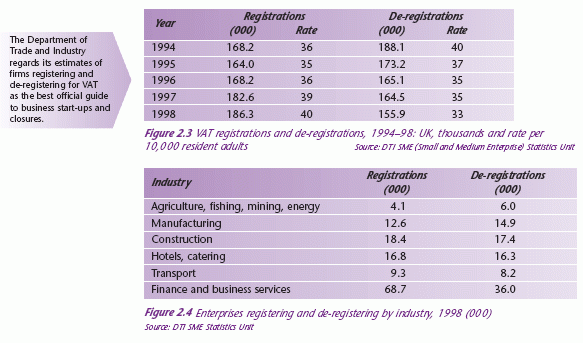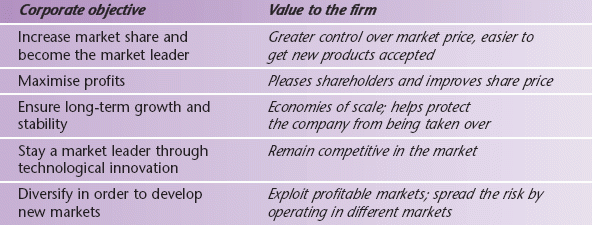The Private Sector
Structure of the UK Economy
After studying this section you should be able to
- describe briefly the two sectors of the UK’s mixed economy
- name the main types of organisation in both sectors
The private and public sectors
Businesses in the UK are normally grouped into private sector and public sector organisations. Private sector firms are set up by individuals, entrepreneurs who seek to make profit from their business activities. Although many private sector firms are controlled by entrepreneur(s), they may be owned by different people (or organisations), for example, companies owned by shareholders, either as private or institutional (organisation-based) investors. This may lead to a conflict between ownership and control.
As well as making profit, entrepreneurs may have other objectives, e.g.:
- job satisfaction
- employment
- power and prestige.
The public sector consists of those organisations owned and/or financed by central and local government. This sector provides goods and services to the community through public corporations, local government and other statutory agencies (e.g. the National Health Service). The profit motive is not so prominent: the emphasis in the public sector is on providing for the community by the community, using funding supplied through taxes and government borrowing.

Main features of the private sector
After studying this section you should be able to
- explain the importance of profit to an entrepreneur
- describe the relevance of incorporation and limited liability to business
- explain the nature and purpose of mission statements and corporate objectives
Entrepreneurs and profit

Why is profit important to an entrepreneur? It provides a measure of success for the business, as well as acting as an indicator to others. Prospective lenders use the profit figure to decide whether to lend, and potential entrepreneurs look at present profit levels when deciding whether to enter the industry.
Profit, as the reward for taking risk, is not guaranteed: many firms make losses and close. Even when profit is made, it may be small and regarded by the entrepreneur as poor reward for risk-taking: the firm’s profitability is too low. This results in continual change in the structure of the private sector.
Economists view profit as the reward of one of the factors of production (enterprise).

Figure 2.3 shows that there were 186,300 registrations in the UK in 1998, and 155,900 de-registrations (1 in 9 of the businesses registered at the start of the year). The number registered in 1998 had risen by 2% on 1997, to its highest level for five years. Figure 2.4 illustrates the move from the primary and secondary sectors to the tertiary sector. In 1998, the number of registrations fell compared with 1997 in agriculture/fishing (600) and manufacturing (900): in the same period, de-registrations for agriculture/fishing and manufacturing both rose by 100. The net result was a loss of some 4,000 businesses, compared with a net gain of nearly 33,000 in business services: this industry grew by over 100,000 in the five years to 1998, to 1 in 4 of all VAT registered UK businesses.

KEY POINT: Individuals in the private sector try to make profit by acting as entrepreneurs in the market-place. The profit motive forms the foundation of the private sector.
Legal liability and legal status
Most large commercial companies are limited by share and must include ‘limited’ or ‘plc’ as appropriate in their name. This acts as a warning to those trading with such a company because any debts it incurs from trading may not be recoverable due to the limited liability of its owners (shareholders).
Where a limited company cannot pay its debts from its own financial resources, it cannot make the owners use their personal finances to meet these debts. Sole traders and partnerships have unlimited liability: if business debts cannot be met from the firm’s own resources, the owner(s) can be forced to sell personal assets to cover these business debts.
Limited liability encourages greater investment than would otherwise take place, and ensures a demand for stocks and shares.
Other companies, for example some examination bodies and professional associations, are limited by guarantee; members of such a company guarantee its business debts, up to a given maximum.
KEY POINT The benefit of limited liability to the economy is that it encourages people to risk owning and/or investing in companies, because they know their liability (losses) will be limited to the amount they have agreed to invest.
Another important difference between these forms of business ownership is in their legal status. Limited companies are incorporated bodies. ‘Incorporation’ means that a company has a separate legal existence from its members (shareholders). Sole traders and partnerships are unincorporated businesses and do not have a legal existence that is separate from that of the owners.
A limited company has the legal authority to:
- own property
- enter contracts in its own name
- sue (and be sued) in the courts.
Goals and objectives
Firms set themselves goals to achieve. The mission statement of a company states its overall aim and purpose. This is then translated into corporate objectives.

Here's an example mission statement
- Our reason for being
- To dedicate our business to the pursuit of social and environmental change.
- To creatively balance the financial and human needs of our stakeholders: employees, franchisees, customers, suppliers and shareholders.
- To courageously ensure that our business is ecologically sustainable: meeting the needs of the present without compromising the future.
- To meaningfully contribute to local, national and international communities in which we trade, by adopting a code of conduct which ensures care, honesty, fairness and respect.
- To passionately campaign for the protection of the environment, human and civil rights, and against animal testing within the cosmetics and toiletries industry.
- To tirelessly work to narrow the gap between principles and practice, whilst making fun, passion and care part of our daily lives.
Mission statement, The Body Shop International plc, 1999
KEY POINT: Corporate objectives become measurable when developed into more detailed functional objectives: these are expanded into individual objectives for employees to achieve. Achievement can be measured through appraisal of individuals and by adopting a management by objectives (MBO) approach.
